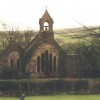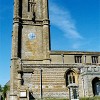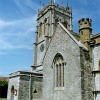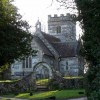To the family historian Wareham is a registration district, suggesting a largish centre for trade and commerce and as such deserving to keep its alphabetical position on your list of places to spend a day out. Perish that thought. Wareham, situated between the Rivers Frome and Piddle, is a low skyline town hindered by nothing remotely resembling the term high rise or concrete jungle. Even the town’s Italian restaurant on North Street shelters under an ancient thatch.
As anyone with roots in the town will know many of the milestones in the lives of their ancestors were probably marked by events at Lady St. Mary’s church. To get there from the centre of town proceed along East Street taking a right turn into Church Lane. On the left as you proceed along Church Lane to Lady St. Mary’s there is, set back a little, a building which may hold the key to overcoming many a family historians Wareham ‘brickwalls.’
In the 17th century Wareham was home to a large congregation of Dissenters and in 1689 they built the Presbyterian Meeting House and made it their spiritual home. Partly destroyed in the great fire of 1762 it was rebuilt later that year. If your ancestors disappeared from the parish records there is a strong possibility record of them will be here. More recently the church has been known as the Congregational Church and is now known as the United Reformed Church.
The faithful have been worshipping at the site of Lady St.Mary’s Church for at least 1300 years. The nearby 16th century priory is now a hotel. The present building dates mostly from 1842 but the St. Edwards Chapel of 1100 remains. We will look at the church and its history in more detail in a future article about the history of Wareham and its churches.
In the small square to the front of the church entrance there is a stone recording the planting of a tree to commemorate the wedding of HRH the Prince of Wales to Lady Diana Spencer on the 29th July 1981.
Walk through the small alleyway and you will be in the area known as the Quay where you can sit by the river and be served by pubs and restaurants. From the South Bridge you can look down over the Quay and upstream you will see moored many small sailing craft. The River Frome is tidal at this point. On the hard standing at the foot of the bridge there is a man who will hire you a small motor boat by the hour.
Near the bottom of South Street on your left and hidden away down a short alley is the entrance to Holy Trinity Church. On this site before the Norman Conquest there was a chapel dedicated to St. Andrew. Dorset historian John Hutchins was installed as rector in 1743. Nowadays the building is home to the Purbeck Information and Heritage Centre.
Continuing up South Street on your left is the Bear Inn and Hotel and across the road a fine three story Georgian property, The Manor House built in 1712. There is a small shopping development here on the site of the former church dedicated to St. John.
We are back at the cross roads at the centre of the town and what would have been the business heart of the place and rather confirms Wareham as a small town. Here on the corner of North and East Streets is the Town Hall in earlier days the site of St. Peter’s parish church dating from 1321. Damaged in the great fire of 1762 it was rebuilt as the Town Hall and jail in 1768. It was rebuilt again in 1870 and nowadays it is the town’s museum and also home to the local Tourist Information Centre.
Opposite the Town Hall in East Street is an interesting building with a bell tower. Actually the tower was part of the Town Hall until that building was rebuilt in 1870 and the tower moved across the street. John Streche an Essex man who had property in the town founded the Almshouses in 1418 and now they are private residences; new almshouses were built in 1908 at Westport. The building we see here today was re-built in 1741 by Henry Drax and John Pitt, Members of Parliament for the Borough.
Let us turn about and cross over into West Street and continue to Bloody Bank – the town’s place for executions in days past. The historian John Hutchins tells us the place got its name after five men involved in the Monmouth Rebellion were sent there in 1685 by Judge Jeffreys to be hung, drawn and quartered. But the place could have earned its name earlier as executions are believed to have been carried out here from as far back as 1213.
We can now walk along the bank up to the North Walls, from where there is an excellent view across to the River Piddle and the North Bridge. Continue round to the top of North Street and visit Wareham’s jewel: St. Martin’s Church.
The writer had mixed feelings towards the artist selling his pictures from inside the church and wondered what our Lord might have thought about it. On the other hand had he not been there it might not have been possible to gain access and his wildlife paintings were rather good.
The Saxon church is small and we are told St. Aldhelm founded a church here in 698. The present building dates from early in the 11th century and has a number of wall paintings and inscriptions the earliest said to date from the 12th century. After 1736 the church was only used for a brief period and then only for baptisms and marriages. It fell into disuse and was unused for about 200 years. In 1935 it was restored and at the request of his younger brother an effigy of T.E. Lawrence – “Lawrence of Arabia” – was placed in the north aisle.
As you leave St. Martin’s you can see straight down North Street to the cross roads at the centre of town and as you walk that way you will notice the Methodist church on your left.
A day well spent; St. Martin’s alone is worth the trip but do check first that it is open.



